Book Review : New York, New York: Magic and More Misery
- Share via
Metropolis: New York as Myth, Marketplace and Magical Land by Jerome Charyn (Putnam’s: $18.95)
Maybe a novelist who knows his way around the back alleys is the ideal writer for an account of New York, probably America’s most rich-poor, powerful-helpless, hearty-haughty city. Jerome Charyn takes on the town with a lover’s panting enthusiasm, embracing almost everything and making a few romantic allowances for brutal realities, mixing all the ingredients and spices of the old melting pot--Irish, Italian, Jewish, Asian, black, Latino, even a few historic Dutch uncles.
And he makes them fun, in this idiosyncratic, humanized narrative of American extremes. One trouble common to city writing is the use of paradox to cover complexity; it becomes a way to evade more profound comprehension. A second trouble is comprehension itself, the need to explore the whole map--historical, political, sociological. In the course of being conscientious, the author often turns tedious.
Charyn avoids those potholes by making choices and staying close to what he sees or feels. Yes, he includes obligatory sessions with Mayor Edward Koch, even rides up the East River with him on a police launch to see fireworks on the Fourth of July, but other leading characters in this survey of our shiny-filthy megaburg are less well-known. They include people who once worked magic in New York and people who now struggle without illusion.
Small Town to Slum
Samuel Lionel Rothapfel came from Minnesota to New York City’s Lower East Side in 1895, from small town to slum. He’s the man who became Roxy, to have his own movie palace, his own chorus line before Broadway turned punk and porn.
Herman Badillo was the son of a Puerto Rican minister. He grew up and went to school in East Harlem, worked up to deputy mayor and now rages against the school system for its failures with minority students.
Benjamin Ward is a black police commissioner who knows about 19th-Century New York, when blacks and Indians, together, went whaling off Long Island.
Katherine Wei, the vice president of a shipping firm, fled from China when the Japanese arrived. Now she berates New York Chinese for being snobbish on one hand and self-abasing on the other.
And there is Douglas Leigh, the wizard of light who glows like Charyn’s talisman. Leigh once built a waterfall for Pepsi-Cola on Broadway; he designed the famous Camel’s smoke rings that puffed for 16 years, and he illuminated the city skyscrapers for America’s Bicentennial year. Charyn understands how the right kind of artifice--water and smoke and cosmetic color--can cover a multitude of urban sins.
Magic and misery are neighbors in crowded New York; novelists even share imagery space. Charyn remembers Leigh’s great winged horse for Mobil Oil, flying from a blimp when the author was a boy in the Bronx. Mark Helprin might have seen the same neon animal; he wrote “Winter’s Tale” in 1983, a fictional saga of New York history, featuring a flying horse that managed to soar above the desperation of downtown.
Reader Required to Look Up
Such imagery, Helprin’s or Charyn’s, requires a reader willing to go along for the mythical ride, to look up above the skyline rather than down at the grit of the streets. New York loyalists are likely to love the invitation; New York defectors may be unwilling to suspend their disenchantment.
Yet Charyn is never a dull guide, whether visiting Ellis Island where so much of it began or touring Bellevue, the mental hospital, where so much of it seems to end. His eye is acute, his streets smell right, and his people talk with passion. His own passion, alas, sometimes promotes hyperbole. Unable to wave arms at the audience, he hurls words: Mayor Koch is almost always introduced as a golem, a power artificially created to save the city from itself. And here, near the end of the ride, is Charyn being novelist-turned-reporter: “New York is that dream town at the edge. If it cannot school its children or accommodate the young, provide more than penthouses, it will become a ruin with a remodeled face, without energy or remorse. . . . A painted corpse.”
“Metropolis” is as bright as a Douglas Leigh billboard--at once an entertainment and a contrivance.
More to Read
Sign up for our Book Club newsletter
Get the latest news, events and more from the Los Angeles Times Book Club, and help us get L.A. reading and talking.
You may occasionally receive promotional content from the Los Angeles Times.










